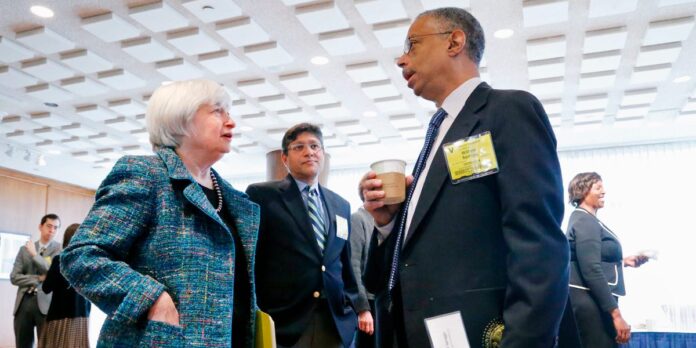- The pandemic forced millions of workers out of work, so why are millions quitting their jobs?
- William Spriggs, chief economist for the AFL-CIO, broke down why people are leaving work.
- Some workers are switching to new sectors, while others may be burnt out or opting out entirely.
A strange paradox has emerged in the reopening economy: Millions of workers are quitting, even though millions were laid off during the pandemic and abruptly left without work.
It’s what psychologist Anthony Klotz has termed the “Great Resignation,” as reported by The Guardian, and the number of people who are unemployed after quitting their jobs reached a new pandemic-high in June.
Separately, the Bureau of Labor Statistics reported on Wednesday that 3.6 million people quit their jobs in May, with only one available worker for every job opening. That came after 4 million people quit their jobs in April, itself a 20-year high. While the quits rate may be slightly declining from April to May, it’s still the highest since December 2000, when the BLS started collecting this data.
So why are people quitting, and why is it so hard to hire right now?
Ahead of Wednesday’s data release, Insider spoke to Dr. William Spriggs, an economics professor at Howard University and chief economist at the AFL-CIO, and he offered three reasons America is seeing so many people say, “I quit.”
(1) A whole lot of people have retired
Spriggs told Insider that the number of people retiring is a “huge factor” in the current labor market, as the pandemic looks to have accelerated the end of workers’ careers, especially in certain industries.
“I think a lot of people who were 59 or 60 last year” got enough support so they were prepared to retire in 2021. This created a loop where now-empty roles need to be backfilled, and none of the firms hiring had expected they’ve have to make up for so many retirees.
An October 2020 report from the Retirement Equity Lab found that workers over 55 had unemployment rates higher than the younger cohort for the first time in 50 years — meaning that perhaps they cashed out their stimulus checks, enhanced unemployment benefits, and opted out of job searching together. That could be a serious blow to the economy.
The AARP reported on the disparate impact for older workers. Those who are lower-income were more likely to involuntarily lose their jobs. And some retirees opted to duck out of the labor force earlier than expected due to COVID fears.
Julia Pollak, a labor economist at job site ZipRecruiter, previously told Insider that the biggest labor shortages are in the fields that saw the biggest employment hits during the pandemic. Older workers may have taken a look at the state of the industry, and decided just to retire instead, she said.
(2) Workers are switching into better jobs
Workers in lower-paying jobs may be ducking out of one job for another. For instance, they could be leaving behind leisure and hospitality jobs — which despite some recent wage growth, still pay far lower than many professions — for jobs with even higher pay growth. Even working at a fulfillment center offers consistent hours and pay, Spriggs noted, something that isn’t generally true for restaurant work.
Spriggs said that with a lot of switching between roles, employers seem to favor workers who already employed: “The workers who are employed are finding ways to get jobs in the sectors that are expanding and hiring.”
In May, the quit rate in leisure and hospitality remained stubbornly high at 5.3%.
“It’s not like workers have all this power or new power, but it’s just simply that there are more opportunities because these other sectors are finally expanding,” Spriggs said.
(3) Workers are no longer ‘captive’ to jobs
Finally, the expanding web of new opportunities has disrupted the “captive nature” of ubiquitous, low-paying jobs, according to Spriggs — opening workers’ eyes and wallets to a wider web of opportunity, even if they’re not moving directly into a new position.
Not being captive to a job means workers could also be waiting things out, whether due to COVID fears or a mismatch between what’s available and their particular skillset. For instance, the OECD is warning long-term unemployment could remain high in wealthier countries because of a mismatch between open positions and workers’ skills.
Of course, people also quit because they just don’t like their jobs. Burnout is the primary driver for the 95% of workers considering quitting right now, according to a new Monster.com survey, while many workers are “rage quitting,” as Insider’s Aine Can reported, after getting fed up with treatment and safety precautions at their places of work.
While people might have wanted to quit just as much in the before times, the COVID economy is giving them the confidence to say no thanks — for now.
Credit: Source link









